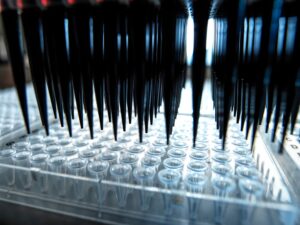APPLICATIONS OF TECHNOLOGY:
- Mass spectrometry
- High-density microarray applications
- Food and pharmaceutical laboratory research
BENEFITS:
- Rapid and accurate high-throughput testing
- More repeatable than manual pipetting
- Ensures more efficient and complete sample transfer
- Reduced risk of sample loss or contamination
- Ability to interface with existing fluid handling machinery
BACKGROUND:
Current pipette tips are primarily designed for liquid transfer using pneumatic actuation. This method relies on creating a vacuum or pressure differential to aspirate and dispense liquids. While effective for general purposes, pneumatic actuation can be less precise when dealing with small volumes. It also may contribute to droplet formation and coalescence (droplets sticking together), which can result in cross-contamination. This issue is a significant concern in high-throughput and sensitive applications.
Another notable limitation is the gap that often exists between the pipette tip and the target plate, especially in automated systems, as current commercial devices are designed for contactless dispensing. In automated systems, the gap is due to variability in the plate flatness, tip size, and attachment to the dispense head and can result in incomplete transfer of liquids, especially for small (<µL quantity). This can result in incomplete transfer of liquids, impacting the efficiency and accuracy of the process. Additionally, standard pipette tips are typically made from rigid materials, which makes them stiff. This rigidity is necessary for durability and to maintain shape integrity during liquid transfer. However, when combined with the gap issue, there is the potential for variability in dispensing volumes or not contact at all. This poses a challenge in applications where precision is critical, especially in automated systems.
TECHNOLOGY OVERVIEW:
JBEI researchers have developed a pipette tip called Flexi-tips, designed to address the limitations faced by current pipette tips in high-precision applications. The spring-loaded design prevents gap formation between the target plate and tip via a compression mechanism. The contact-based transfer aids in creating more densely packed deposition patterns compared to the current 96-well format for high-density microarray applications. To date, 6144 well format patterns have been achieved; scientists have plans for further improvements. For high-throughput fluid handling robots using 96-well plates, this design accounts for the variability in geometries of the target plate and individual pipette tips to ensure all make contact prior to dispense. This reduces the occurrence of droplet coalescence and the risk of cross-contamination, crucial in industries using automated high-throughput systems to measure sample purity.
A feature of this technology is its capability to accurately transfer small volumes (100 nl or less) to the target plate. In some implementations, this precision is achieved by utilizing a small polydimethylsiloxane (PDMS) bead at the end of the pipette tip that operates like a stamp. When used to collect the sample from a well plate, the relevant solvent is absorbed by the bead and deposits the small quantity sample on the target plate with high fidelity. The use of the PDMS bead makes it an ideal tool for applications where accurate dosing of nanoliter volumes is required or sample availability is limited.
Currently, the spring mechanism is being revised for optimum performance and repeatability on existing liquid handling robots. This compatibility coupled with improved performance allows laboratories to enhance their precision and efficiency without the need for additional investment in new robotic systems. By bridging the gap between advanced liquid handling capabilities and existing infrastructure, this technology offers a practical, impactful solution to the challenges faced in modern laboratory settings.
DEVELOPMENT STAGE:
Laboratory scale, similar system validation in relevant environment.
PRINCIPAL INVESTIGATORS:
- Trent R. Northen
- Kshitiz Gupta
IP Status:
Patent pending
